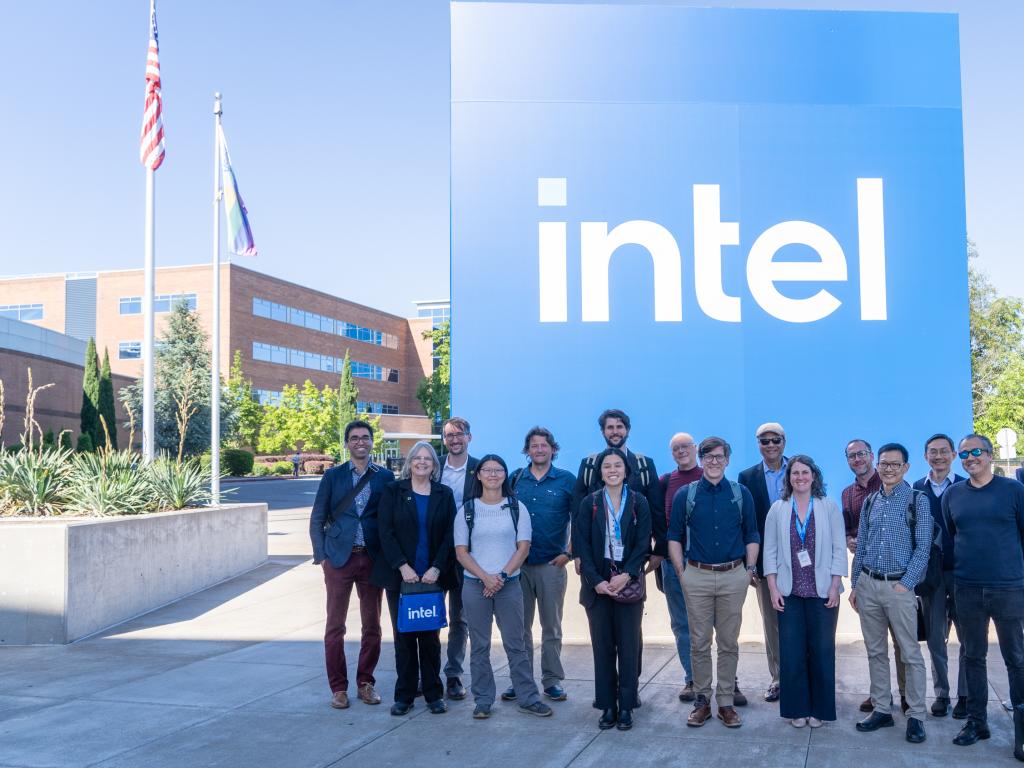
In early June, staff from the University of Oregon’s Office of the Vice President for Research and Innovation and several faculty members met with representatives from Intel Corporation at the company’s Hillsboro, Oregon facility to discuss further opportunities for collaboration and workforce development.
Organized by Launch Oregon Board Trustee Bryan Wolf and Anshuman “AR” Razdan, vice president for research and innovation, the overarching goal of the meeting was to find additional ways to elevate the UO-Intel relationship and pave the road for UO’s growing involvement in the semiconductor industry in the region.
“The semiconductor industry is at an inflection point, and similarly the UO is as well,” Razdan said in remarks during the meeting. “We are traditionally a liberal arts university, but we are transitioning to include more engineering and applied sciences. We’d like to grow the semiconductor workforce pipeline and create a bidirectional exchange of knowledge with our partners at Intel.”
Sanjay Natarajan, senior vice president and general manager for technology research at Intel Foundry, shared how Intel is furthering its investment in Oregon following supply chain disruptions that were exposed by the COVID-19 pandemic.
“Oregon is Intel’s R&D crown jewel,” Natarajan said, explaining how the company is investing more than $100 billion in the US over five years to help balance the global semiconductor supply chain As the only leading-edge semiconductor company with its R&D based in the US, Intel’s Hillsboro location boasts the largest R&D semiconductor fab on the planet with cleanroom space equivalent to the area of 26 football fields.
Just as Intel considers itself a steward of Moore’s Law—the observation that the number of transistors on an integrated circuit will double every two years—the University of Oregon sees itself as a steward of a burgeoning, highly skilled workforce in its students. The Semiconductor Industry Association projects that the semiconductor workforce will grow by nearly 115,000 jobs by 2030, more than 50% of which will require at least a four-year degree.
To meet that need, the UO is investing in relationships with partners like Intel to build both bold institutional collaborations and scientist-to-scientist connections.
Research, Talent Development, and Innovation
Following opening remarks, faculty and research staff members from the departments of physics and chemistry and biochemistry, as well as CAMCOR, the UO’s materials characterization facility, and the Materials Science Institute, gave presentations on their research and how it aligns with Intel R&D. Topics included sustainable materials, photonics, and novel materials and characterization. Presenters also shared how UO programs and research core facilities serve industry partners by developing talent through graduate programs and providing specialized materials testing.
Russell Natter, a principal engineer in Intel Oregon’s technology development group, said there is a global semiconductor technology race underway between Taiwan, South Korea, and the US. Yet, in the past five years, only 9 to 11% of Intel Oregon’s new engineers have come from Oregon schools.
“There is room for Oregon to improve and increase representation from our state substantially,” said Natter.
The UO seeks to address this issue not only by training graduate students participating in the Knight Campus Graduate Internship Program and Advanced Materials Analysis and Characterization Master’s Degree Program, but also through planned efforts that include a new undergraduate Materials Science degree and Quantum Technology Masters Internship program.
“This meeting was only the first major step in what will be a sustained, ongoing effort to build a strategic relationship,” said Bryan Wolf, Launch Oregon board trustee. “The goal over time is to enlist other key partners in government, fellow institutions like Oregon State University, alumni, and the industry to establish and solidify Oregon as a center of excellence in the semiconductor industry, with UO as a keystone.”
Learn more about how advanced materials and next-generation semiconductors are propelled by Oregon ingenuity.
